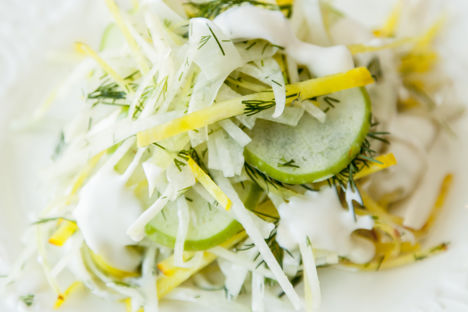Mandolines are used to slice ingredients (particularly vegetables) quickly, efficiently and uniformly. They allow you to slice much more quickly than with a knife but take great care – many a chef has lost the tip of a finger to a razor-sharp mandoline blade.
Uses
Mandolines can be used to prepare all manner of firm vegetables, for example, slicing potatoes for dauphinoise, cutting courgette ribbons and slicing ginger or garlic. Gary Jones uses a mandoline to finely slice fennel for a garnish on his Scallop and tuna ceviche while the stunning radish rounds on Robert Thompson’s Mackerel ceviche can easily be made using a mandoline.
Beetroots are particularly good vegetables for slicing, as they cut cleanly and hold their shape. This is demonstrated beautifully in Simon Hulstone’s Beetroot and goat’s curd samosa where paper-thin beetroot slices replace the samosa pastry.
As well as adding consistency and finesse to high-end dishes, mandolines are a great everyday bit of kitchen kit. Vegetables for a stir-fry can be chopped and cooked within minutes and they also make light work of shredding cabbage for coleslaw.
Equipment
Mandolines can range from very basic models with one slicing thickness to more complex models with fittings which allow you to julienne or dice vegetables. Many mandolines have at least a few different thickness settings to allow you to slice depending on the thickness needed.
Mandoline blades must be kept razor-sharp to ensure clean cuts – you can sharpen the blade yourself, much as you would sharpen a knife.
Mandolines are relatively safe utensils when used properly but due to the sharpness of the blade, many models come with a hand guard for extra protection.
Get in touch
Please sign in or register to send a comment to Great British Chefs.



